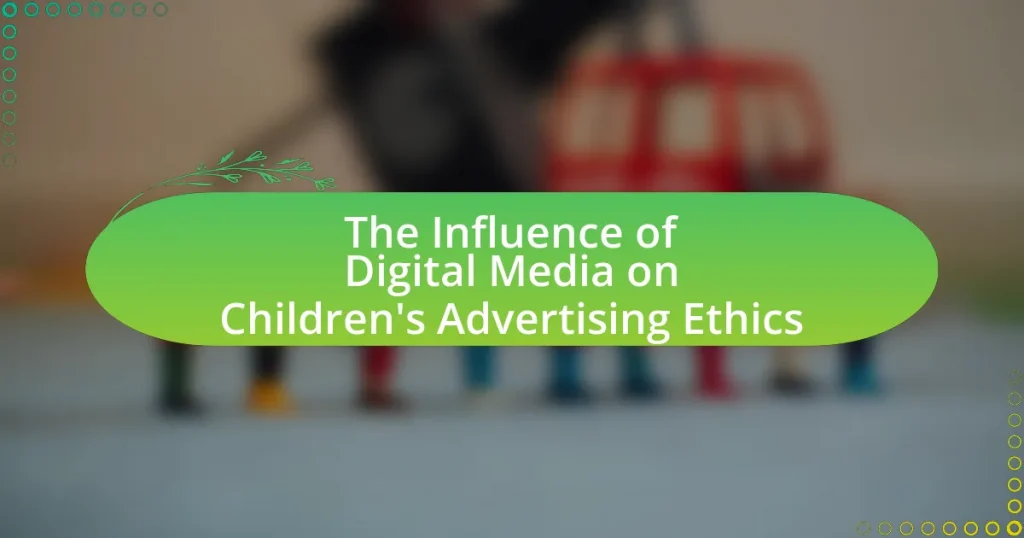The article examines the influence of digital media on children’s advertising ethics, highlighting how advancements in technology have transformed advertising strategies targeted at young audiences. It discusses the characteristics of digital media, such as interactivity and targeted content, that affect children’s perceptions and susceptibility to advertising. Ethical concerns related to manipulation, privacy, and the effectiveness of regulations are explored, alongside the role of parents and educators in addressing these issues. The article emphasizes the need for transparency and responsible advertising practices to protect children from misleading content and promote ethical consumption.
What is the Influence of Digital Media on Children’s Advertising Ethics?
Digital media significantly influences children’s advertising ethics by altering how advertisements are created, targeted, and consumed. The rise of platforms like social media allows advertisers to engage with children directly, often blurring the lines between entertainment and marketing. Research indicates that children are more susceptible to persuasive techniques used in digital media, such as influencer marketing, which can lead to ethical concerns regarding manipulation and consumerism. A study published in the Journal of Advertising Research highlights that children exposed to digital advertisements are less likely to recognize them as marketing, raising ethical questions about informed consent and the responsibility of advertisers.
How has digital media transformed advertising targeted at children?
Digital media has transformed advertising targeted at children by enabling highly personalized and interactive marketing strategies. Traditional advertising methods, such as television commercials, have been largely replaced by digital platforms that allow advertisers to collect data on children’s preferences and behaviors, leading to tailored content that resonates more effectively with young audiences. For instance, platforms like YouTube and social media channels utilize algorithms to serve ads based on individual viewing habits, increasing engagement rates. According to a study by the American Psychological Association, children exposed to targeted digital ads are more likely to develop brand loyalty and make impulsive purchasing decisions, highlighting the significant impact of digital media on children’s advertising ethics.
What are the key characteristics of digital media that affect children’s advertising?
The key characteristics of digital media that affect children’s advertising include interactivity, accessibility, and targeted content. Interactivity allows children to engage with advertisements through games and quizzes, making them more appealing and memorable. Accessibility ensures that children can easily access digital platforms, increasing their exposure to advertisements. Targeted content utilizes data analytics to deliver personalized ads based on children’s preferences and behaviors, enhancing the effectiveness of marketing strategies. Research indicates that children are particularly susceptible to these characteristics, as they often lack the critical skills to discern advertising intent, leading to potential ethical concerns in advertising practices aimed at them.
How do these characteristics influence children’s perceptions of advertisements?
Children’s perceptions of advertisements are significantly influenced by characteristics such as visual appeal, messaging, and interactivity. These elements capture children’s attention and shape their understanding of products. For instance, vibrant colors and animated characters can create a sense of excitement, making the advertisement more memorable. Research indicates that children are particularly responsive to advertisements that feature relatable characters or engaging storylines, which can lead to increased brand recognition and preference. A study by the American Psychological Association found that children aged 8 to 12 are more likely to trust advertisements that utilize familiar themes and characters, demonstrating how these characteristics directly impact their perceptions and purchasing behaviors.
Why is advertising ethics important in the context of children’s media consumption?
Advertising ethics is crucial in the context of children’s media consumption because children are particularly vulnerable to persuasive messaging and may not possess the cognitive skills to critically evaluate advertisements. This vulnerability necessitates ethical standards to protect children from misleading or harmful content. Research indicates that children are more likely to accept advertising claims as truthful, which can lead to unhealthy consumption patterns and materialism. For instance, a study published in the Journal of Advertising Research found that children aged 8 to 12 are significantly influenced by advertisements, often failing to recognize the intent behind them. Therefore, ethical advertising practices are essential to ensure that marketing directed at children is truthful, age-appropriate, and does not exploit their naivety.
What ethical concerns arise from advertising to children in digital spaces?
Advertising to children in digital spaces raises significant ethical concerns, primarily related to manipulation, privacy, and the potential for harmful content exposure. Children are particularly vulnerable to persuasive techniques used in digital advertising, which can lead to unhealthy consumer behaviors and unrealistic expectations. Research indicates that children often lack the cognitive ability to critically evaluate advertisements, making them susceptible to misleading claims. Additionally, the collection of personal data from children for targeted advertising poses serious privacy issues, as many platforms do not adequately protect young users’ information. The American Psychological Association has highlighted that such practices can exploit children’s developmental stages, leading to long-term negative impacts on their well-being and consumer habits.
How do these ethical concerns differ from traditional advertising methods?
Ethical concerns in digital media advertising, particularly regarding children, differ from traditional advertising methods primarily due to the pervasive nature of digital platforms and their ability to collect data. Digital advertising often utilizes targeted marketing strategies that can exploit children’s online behavior and preferences, raising issues of privacy and manipulation. For instance, a study by the American Psychological Association highlights that children are more susceptible to persuasive techniques used in digital environments, which can lead to unhealthy consumption patterns. In contrast, traditional advertising methods typically involve broader audience targeting without the same level of data-driven personalization, thus presenting fewer ethical dilemmas related to privacy and exploitation.
What role do regulations play in children’s advertising ethics in digital media?
Regulations play a critical role in shaping children’s advertising ethics in digital media by establishing guidelines that protect young audiences from misleading or harmful content. These regulations, such as the Children’s Online Privacy Protection Act (COPPA) in the United States, mandate that advertisers obtain parental consent before collecting personal information from children, thereby ensuring that advertising practices are transparent and ethical. Furthermore, the Federal Trade Commission (FTC) enforces rules that prohibit deceptive advertising targeted at children, which helps to maintain a standard of honesty in marketing communications. By setting these legal frameworks, regulations help to safeguard children’s rights and promote responsible advertising practices in the digital landscape.
What are the current regulations governing children’s advertising in digital media?
Current regulations governing children’s advertising in digital media primarily include the Children’s Online Privacy Protection Act (COPPA) in the United States, which mandates that websites and online services directed at children under 13 must obtain parental consent before collecting personal information. Additionally, the Federal Trade Commission (FTC) enforces guidelines that prohibit deceptive advertising practices targeting children, ensuring that advertisements are clearly distinguishable from content. In the European Union, the General Data Protection Regulation (GDPR) imposes strict rules on data collection and processing for minors, requiring explicit consent from parents or guardians. These regulations aim to protect children from exploitation and ensure transparency in advertising practices.
How effective are these regulations in protecting children from unethical advertising practices?
Regulations aimed at protecting children from unethical advertising practices are moderately effective, but their impact varies significantly by region and enforcement. For instance, the Children’s Online Privacy Protection Act (COPPA) in the United States restricts the collection of personal information from children under 13, which indirectly limits targeted advertising practices. However, a study by the Federal Trade Commission found that many websites still fail to comply with these regulations, indicating gaps in enforcement and effectiveness. Additionally, the effectiveness of regulations is often undermined by the rapid evolution of digital media, making it challenging to keep rules current and relevant.
How do parents and educators perceive the influence of digital media on children’s advertising ethics?
Parents and educators generally perceive the influence of digital media on children’s advertising ethics as significant and concerning. They believe that digital media exposes children to persuasive advertising techniques that can manipulate their understanding of ethical consumption. Research indicates that 70% of parents express worry about the impact of online advertisements on their children’s values and decision-making processes. Educators also highlight the need for media literacy programs to help children critically evaluate advertising content, as studies show that children under the age of 8 often cannot distinguish between entertainment and advertising. This perception underscores a collective concern about the ethical implications of digital media on young audiences.
What concerns do parents have regarding digital advertising aimed at children?
Parents are primarily concerned about the potential for digital advertising to manipulate children’s perceptions and behaviors. They worry that advertisements may promote unhealthy products, such as junk food, leading to poor dietary choices and obesity. Research indicates that children are particularly susceptible to persuasive advertising techniques, which can distort their understanding of needs versus wants. Additionally, parents express concerns about the lack of transparency in digital ads, as many are disguised as games or content, making it difficult for children to recognize them as advertisements. This concern is supported by studies showing that children often cannot differentiate between entertainment and marketing, raising ethical questions about the targeting of vulnerable audiences.
How can educators address the ethical implications of digital advertising in their teachings?
Educators can address the ethical implications of digital advertising by integrating critical media literacy into their curriculum. This approach enables students to analyze and evaluate the persuasive techniques used in digital advertising, fostering an understanding of how these strategies can manipulate consumer behavior. Research indicates that teaching media literacy can significantly enhance students’ ability to discern advertising tactics, as demonstrated in studies like “Media Literacy and the Role of the Teacher” by Hobbs and Jensen, which highlights the positive impact of media education on critical thinking skills. By incorporating discussions on ethical advertising practices and the potential consequences of misleading advertisements, educators can equip students with the tools necessary to navigate the digital landscape responsibly.
What are the specific impacts of digital media on children’s advertising ethics?
Digital media significantly impacts children’s advertising ethics by increasing exposure to persuasive marketing tactics that can manipulate young audiences. Research indicates that children are more susceptible to digital advertisements due to their interactive nature and the use of engaging formats like videos and games, which can blur the lines between entertainment and advertising. A study published in the Journal of Advertising Research found that children exposed to digital ads are less likely to recognize them as marketing, leading to ethical concerns regarding informed consent and the potential for exploitation. Furthermore, the pervasive nature of social media allows for targeted advertising based on user data, raising ethical questions about privacy and the appropriateness of content directed at children.
How does digital media affect children’s understanding of advertising messages?
Digital media significantly influences children’s understanding of advertising messages by exposing them to a higher volume and variety of ads, which can lead to confusion about the intent and credibility of these messages. Research indicates that children, particularly those aged 8 to 12, often struggle to differentiate between entertainment content and advertising due to the seamless integration of ads within digital platforms. A study published in the Journal of Advertising Research found that children exposed to digital media are more likely to perceive advertisements as part of the content rather than as separate promotional messages, which can distort their ability to critically evaluate the information presented. This blurring of lines can result in children being more susceptible to persuasive techniques used in advertising, ultimately affecting their consumer behavior and ethical understanding of marketing practices.
What cognitive development factors influence children’s interpretation of digital ads?
Cognitive development factors that influence children’s interpretation of digital ads include age-related cognitive abilities, comprehension skills, and critical thinking development. Younger children, typically under the age of 7, often lack the cognitive maturity to distinguish between entertainment and advertising, leading them to accept ads at face value. As children grow older, their ability to understand persuasive intent and recognize advertising techniques improves, particularly around ages 8 to 12, when they begin to develop critical thinking skills. Research indicates that children aged 8 and above can better analyze and question the motives behind advertisements, which affects their interpretation and response to digital ads. This progression in cognitive development is supported by studies showing that as children mature, they become more adept at recognizing the persuasive nature of advertising, thus influencing their overall interpretation of digital content.
How do interactive elements in digital ads change children’s engagement with advertising?
Interactive elements in digital ads significantly enhance children’s engagement with advertising by making the experience more immersive and participatory. Research indicates that children are more likely to interact with ads that include games, quizzes, or clickable features, leading to increased attention and retention of the advertised content. A study published in the Journal of Advertising Research found that interactive ads can boost engagement levels by up to 50% compared to static ads, as children are drawn to the active participation that these elements offer. This heightened engagement can lead to a greater likelihood of brand recall and influence purchasing behavior, demonstrating the powerful impact of interactivity in digital advertising targeted at children.
What strategies can advertisers use to promote ethical practices in children’s advertising?
Advertisers can promote ethical practices in children’s advertising by implementing transparency, age-appropriate messaging, and parental involvement. Transparency involves clearly disclosing the intent of advertisements and ensuring that children understand the difference between content and advertising. Age-appropriate messaging ensures that the content is suitable for the developmental stage of the child, avoiding manipulative tactics that exploit their vulnerabilities. Parental involvement can be encouraged by providing resources and tools that help parents guide their children’s media consumption, fostering a collaborative approach to advertising ethics. Research indicates that ethical advertising practices can lead to increased trust and brand loyalty among families, as seen in studies conducted by the American Psychological Association, which highlight the importance of responsible marketing to children.
What guidelines should advertisers follow to ensure ethical advertising to children?
Advertisers should follow guidelines that prioritize honesty, transparency, and respect for children’s developmental stages to ensure ethical advertising to children. These guidelines include avoiding misleading claims, ensuring that advertisements are clearly distinguishable from content, and not exploiting children’s inexperience or credulity. For instance, the American Psychological Association emphasizes that advertisements should not encourage unhealthy behaviors or materialism, as children are particularly vulnerable to such influences. Additionally, the Children’s Advertising Review Unit recommends that advertisers should not depict violence or inappropriate content in ads targeted at children, reinforcing the need for age-appropriate messaging.
How can transparency in advertising improve ethical standards for children’s media?
Transparency in advertising can significantly improve ethical standards for children’s media by ensuring that marketing practices are clear, honest, and accountable. When advertisers disclose the nature of their content, including sponsorships and promotional tactics, it helps parents and children understand the intent behind the messages they receive. Research indicates that transparency reduces the likelihood of misleading information, which is crucial given that children are particularly vulnerable to persuasive advertising techniques. For instance, the Federal Trade Commission emphasizes the importance of clear disclosures in advertising aimed at children to prevent deceptive practices. By fostering an environment of openness, transparency in advertising not only enhances trust but also encourages advertisers to adhere to higher ethical standards, ultimately benefiting children’s media consumption.
What are the future trends in digital media and children’s advertising ethics?
Future trends in digital media and children’s advertising ethics include increased regulatory scrutiny, the rise of transparency in advertising practices, and a focus on promoting positive social values. Regulatory bodies are likely to implement stricter guidelines to protect children from manipulative advertising tactics, as evidenced by the growing concerns over data privacy and targeted marketing practices. Additionally, brands are increasingly adopting transparent advertising strategies, which involve clear disclosures about sponsored content, aligning with consumer demand for authenticity. Research indicates that companies that promote positive social values in their advertising resonate better with younger audiences, suggesting a shift towards ethical marketing that prioritizes children’s well-being.
How is technology shaping the future of children’s advertising ethics?
Technology is shaping the future of children’s advertising ethics by enabling more targeted and interactive advertising strategies that raise ethical concerns. The rise of digital platforms allows advertisers to collect vast amounts of data on children’s online behavior, leading to personalized ads that can manipulate young audiences. For instance, a study by the American Psychological Association highlights that children are particularly susceptible to persuasive techniques used in digital advertising, which can blur the lines between entertainment and marketing. This shift necessitates stricter regulations and ethical guidelines to protect children from exploitation and ensure that advertising practices are transparent and responsible.
What emerging technologies are influencing advertising strategies for children?
Emerging technologies influencing advertising strategies for children include augmented reality (AR), artificial intelligence (AI), and mobile applications. AR enhances interactive experiences, allowing brands to create engaging advertisements that capture children’s attention through immersive content. AI enables personalized marketing by analyzing data to tailor ads based on individual preferences and behaviors, making them more appealing to young audiences. Mobile applications serve as platforms for targeted advertising, leveraging in-app purchases and notifications to reach children effectively. These technologies are reshaping how brands communicate with children, emphasizing engagement and personalization in advertising strategies.
How might these technologies impact ethical considerations in advertising?
Technologies such as artificial intelligence, data analytics, and targeted advertising significantly impact ethical considerations in advertising by enabling more personalized and potentially manipulative marketing strategies. These technologies allow advertisers to collect and analyze vast amounts of data on consumer behavior, which can lead to the exploitation of vulnerable populations, particularly children, by targeting them with tailored messages that may not be in their best interest. For instance, a study by the American Psychological Association highlights that children are particularly susceptible to persuasive advertising techniques, raising concerns about their ability to critically evaluate marketing messages. This manipulation raises ethical questions regarding consent, transparency, and the responsibility of advertisers to protect young audiences from harmful content.
What best practices can be adopted to enhance ethical advertising in digital media for children?
To enhance ethical advertising in digital media for children, companies should adopt transparency, age-appropriate content, and parental controls. Transparency involves clearly disclosing the nature of advertisements, ensuring children understand they are being marketed to. Age-appropriate content requires that advertisements are designed to be suitable for children’s developmental stages, avoiding manipulative tactics that exploit their vulnerabilities. Implementing parental controls allows parents to monitor and restrict the types of advertisements their children are exposed to, fostering a safer digital environment. Research from the American Psychological Association indicates that children are particularly susceptible to advertising messages, emphasizing the need for these best practices to protect young audiences effectively.
How can collaboration between stakeholders improve advertising ethics for children?
Collaboration between stakeholders can significantly improve advertising ethics for children by creating a unified framework that prioritizes child welfare and responsible marketing practices. When advertisers, regulators, educators, and parents work together, they can establish clear guidelines that limit exploitative tactics and ensure that advertisements are age-appropriate and truthful. For instance, the Children’s Advertising Review Unit (CARU) provides a set of self-regulatory guidelines that advertisers can follow, which are developed in consultation with various stakeholders, including child development experts. This collaborative approach helps to foster accountability and transparency in advertising, ultimately leading to a safer media environment for children.
What role can education play in fostering ethical awareness among young consumers?
Education plays a crucial role in fostering ethical awareness among young consumers by equipping them with critical thinking skills and knowledge about ethical consumption. Through structured curricula that include topics such as media literacy, consumer rights, and the impact of advertising, students learn to analyze and question the messages they encounter in digital media. Research indicates that programs focusing on ethical decision-making can significantly enhance students’ ability to recognize manipulative advertising tactics, leading to more informed purchasing choices. For instance, a study by the National Association of Consumer Advocates found that students exposed to consumer education were 30% more likely to identify misleading advertisements. This demonstrates that education not only raises awareness but also empowers young consumers to navigate the complexities of digital marketing ethically.






